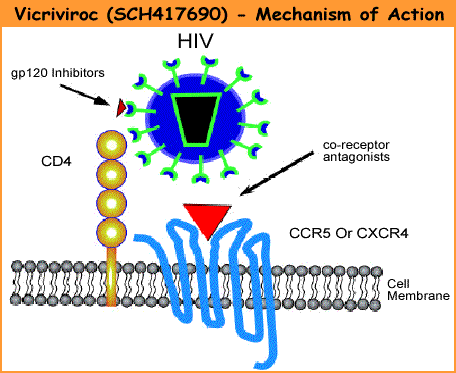By
Liz Highleyman
As
previously reported, VICTOR-E1 was a double-blind Phase 2b trial that included
more than 100 highly treatment-experienced participants in 12 countries with exclusively
CCR5-tropic HIV who had viral load > 1000 copies/mL despite stable antiretroviral
therapy (ART).
Participants
were randomly assigned to receive 20 mg or 30 mg once-daily vicriviroc
or placebo, in combination with optimized background therapy (OBT) containing
a ritonavir-boosted protease inhibitor
(PI).

After
48 weeks, in an intent-to-treat analysis, 56% of patients in the 30 mg vicriviroc
arm and 53% in the 20 mg arm achieved HIV RNA < 50 copies/mL, compared with
14% in the placebo arm. Patients with more active drugs in their OBT regimen were
more likely to achieve undetectable HIV RNA. Rates of virological failure were
13% in the 30 mg vicriviroc arm, 8% in the 20 mg arm, and 38% in the placebo arm.
Mean CD4 cell gains were 102, 134, and 65 cells/mm3, respectively. Rates of serious
adverse events were 12%, 14%, and 22%, respectively, and treatment-related side
effects occurred with similar frequency across arms.
Participants
who completed the 48-week double-blind study were given the option to join an
open-label extension phase in which everyone used 30 mg vicriviroc as part of
an ART regimen including a boosted PI. OBT could also be re-optimized at this
point. A total of 85 people -- all but 1 -- continued the study (32 from the original
vicriviroc 30 mg arm, 35 from the 20 mg arm, and 18 from the placebo arm).
Among
continuing patients, the mean age was about 45 years, about three-quarters were
men, about 70% were Caucasian, and about 15% were black. About 70% were from study
sites in Latin America or South Africa, with the rest from North America or Europe.
The mean baseline viral load was about 2.5 log10 copies/mL (56% < 50 copies/mL)
and the mean CD4 count was 366 cells/mm3 (81% > 200 cells/mm3). The mean duration
on open-label vicriviroc therapy was 13 months.
Results
 | The
mean HIV RNA level fell by an additional 0.32 log10 copies/mL between week 48
and week 96, to 2.07 log10 copies/mL. |
 | The
mean CD4 count increased by an additional 50 cells/mm3, to 422 cells/mm3. |
 | 68%
of patients reported at least 1 adverse event, mostly (93%) mild or moderate in
severity. |
 | 13%
experienced treatment failure (the most common reason for discontinuation during
the extension phase). |
 | 2
patients with virological failure had vicriviroc-resistant virus during the double-blind
phase, and 2 more developed resistance mutations during the extension phase. |
 | The
only adverse events observed in at least 5% of participants were sinusitis (6%),
cough (5%), and insomnia (5%). |
 | 13%
of adverse events were judged to be treatment-related. |
 | 4
patients reported serious adverse events, and 2 discontinued therapy for this
reason: | 1
man discontinued after being simultaneously diagnosed with Hodgkin lymphoma and
Kaposi's sarcoma, which the researchers judged were not treatment-related. |  | 1
woman discontinued due to pregnancy, which ended 1 week later with a spontaneous
abortion (miscarriage). |
|
 | There
were no treatment-emergent deaths, seizures, or liver toxicity events. |
 | There
were 2 cases of new-onset diabetes considered possibly related to the study drug. |
 | Only
1 patient with documented CCR5-tropic HIV at the start of the extension phase
subsequently exhibited CXCR4-tropic or dual/mixed-tropic virus (discontinued due
to treatment failure). |
The
investigators concluded that vicriviroc had a "sustained antiviral effect,
including full virologic suppression and durable CD4+ cell count increases."
"Vicriviroc was generally well-tolerated in this highly treatment-experienced
population, with no apparent vicriviroc-related toxicities," they continued.
"Resistance to vicriviroc was infrequent and developed slowly, generally
in subjects after prolonged therapy with suboptimal OBT, i.e., fewer than 2 active
drugs."Schering-Plough
Res. Inst., Kenilworth, NJ; Brazilmed Assistencia Medica e Pesquisa, Sao Paulo,
Brazil; Federal Univ., Sao Paulo, Brazil; Centro de Referencia e Treinamento em
DST/AIDS, Sao Paulo, Brazil; Orlando Immunology Ctr., Orlando, FL; Montefiore
Med. Ctr., Bronx, NY; Einstein-Montefiore Ctr. for AIDS Res., Bronx, NY; St. Michael's
Med. Ctr., Newark, NJ.
9/15/09
Reference
MC
McCarthy, J Suleiman, R Diaz, and others.Vicriviroc
Long-Term Safety and Efficacy: 96-Week Results from the VICTOR-E1 Study. 49th
Interscience Conference on Antimicrobial Agents and Chemotherapy (ICAAC 2009).
San Francisco. September 12-15, 2009. Abstract H-923.